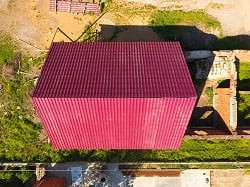
There is no such thing as a perfect roofing material. Each has its own Achilles’ heel, whether it be price, durability or installation complexity. Metal roofing is no exception. You need to weigh all factors, both positive and negative, when choosing metal roofing. Here we outline five of the most common issues experienced with metal roofs.
- Leaking.
Your roof is at constant war with the elements and we have yet to perfect imperviousness in construction materials. Until we invent impenetrable force fields, your roof is susceptible to water sneaking in. A tiny leak can create major issues and every roof installer knows a leak is enemy number one. Causes of leaks can be traced to poorly installed fasteners, improperly formed or installed seams, failed flashing or sealants, or failure to follow manufacturer installation instructions.
- Oil Canning.
Metal roofing, regardless of metal type, has the inherent potential to show stress wrinkling. It can be a result of over-production, frequent stress from coil cutting, inadequate space allotted for expansion and contraction relating to temperatures, shifting of the foundation structure, or improper handling by the installer. It appears as visible waves in the flat surface of your panels. It can be prevented with proper installation and thicker metal selection, but once it occurs, trying to reverse it is as effective as trying to smooth a piece of aluminum foil after it’s off the roll.
- Corrosion.
Metals corrode eventually—it’s science. Metal roofing manufacturers go to great lengths to treat their materials with protective paint systems and coatings to create corrosion-resistant surfaces that can last 60+ years. As mentioned in the introduction, we have yet to reach perfect. There are situations where corrosion can still sneak in like underside corrosion, saltwater corrosion, dissimilar metal interactions or cut edges that are left unsealed.
- Dissimilar Metals.
When a galvanized metal and a non-galvanized metal are in contact in a corrosive environment, as in sitting on top of a building, one of the metals may experience accelerated galvanic corrosion while the other remains unaffected. It’s a result of one metal stealing electrons from the other. An experienced installer will be familiar with these reactions and know how to choose materials suited for each other.
- Installation Error.
The most common source of metal roofing failures is the installer themselves. The problems listed can be mitigated with an attention to detail, a knowledge of materials and proper installation. All three of these can be supplemented with the SCRAIL® RoofLoc® system offered by BECK America. The system was developed by the BECK Group to install metal roofing and facades quickly and efficiently. It’s two times faster than collated screws, and eight times faster than bulk screws. This performance could only be reached by the combination of the pneumatic SCRAIL® RoofLoc® Installation Tool and the patented SCRAIL® RoofLoc®. The fasteners have a 560-pound holding strength, leakproof EPDM-washers that resist temperature contraction, FasCoat® corrosion-resistant finish, and eliminate metal residue to allow for optimal washer seal.
While no metal roof is impermeable, installation using the SCRAIL® RoofLoc® system, in combination with the expertise of a trained installer, can temper the potential risks and lead to a roof that will outlast the structure it protects.
.svg.png)
